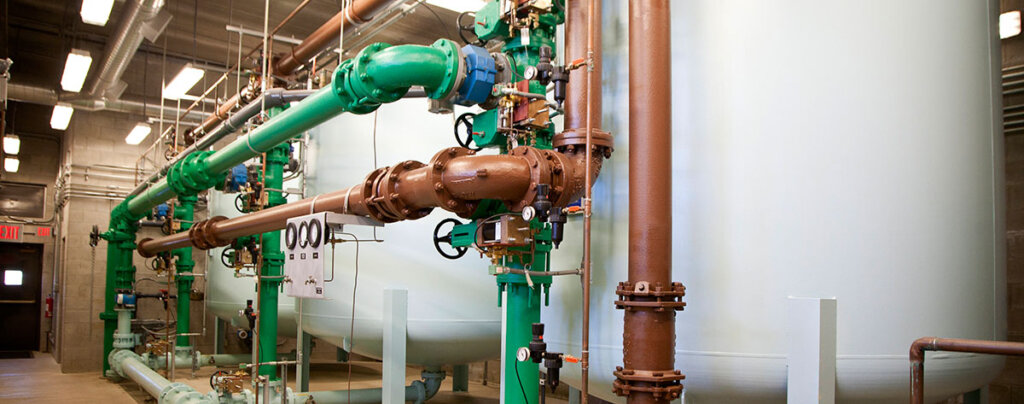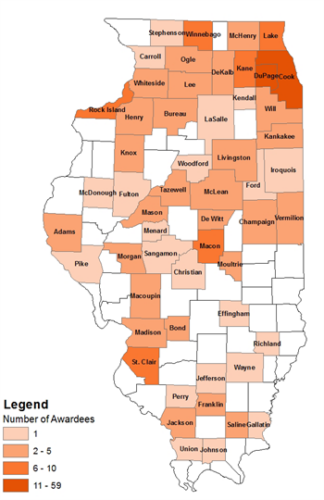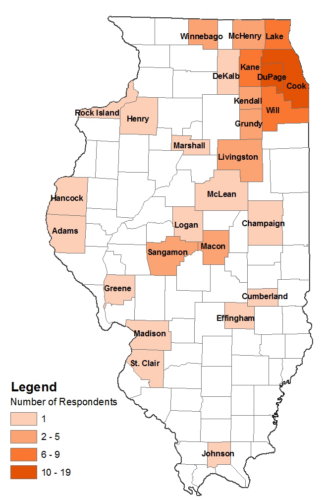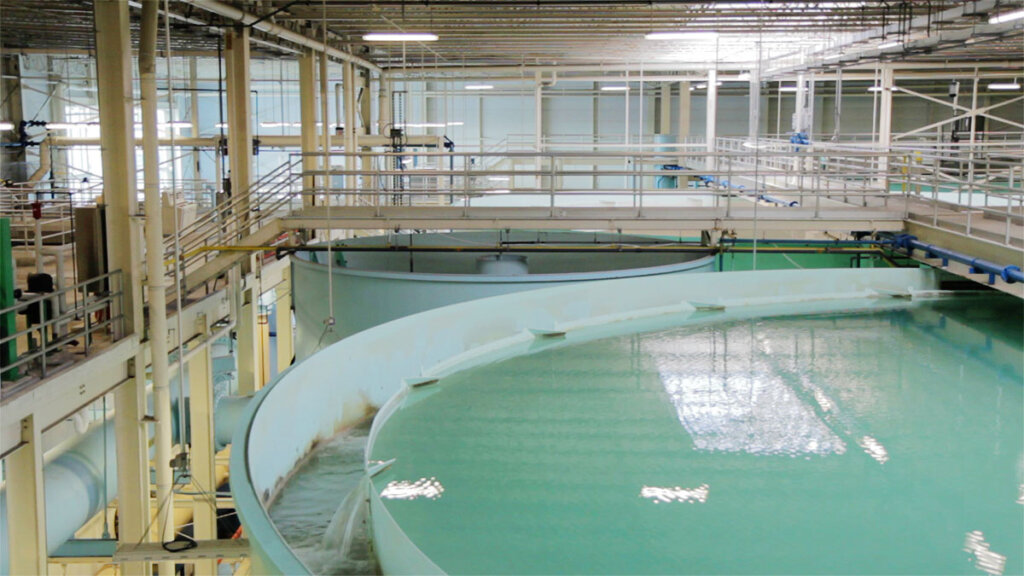Let the Dollars Flow: Streamlining Illinois’ State Revolving Fund

Emily Cikanek
To encourage more communities to apply for a significant but underutilized state low-interest loan for water infrastructure financing, the Metropolitan Planning Council, Ill. Environmental Protection Agency and Metropolitan Mayors Caucus conducted research, stakeholder surveys and interviews to recommend a number of reforms to the State Revolving Fund.
Contents
- Introduction
- What is the State Revolving Fund?
- Goals for improvement
- Research and findings
- Recommendations
- Conclusion and next steps
Without reliable water service infrastructure, communities cannot maintain quality of life, economic vitality or a healthy ecosystem. Feasible funding streams to replace and upgrade outdated community water systems are critically needed. Nationwide, our water supply, wastewater and stormwater infrastructure will require about $126 billion in investments by 2020 for maintenance and upgrades, including replacing old pipes and water mains, and installing more efficient pumps and green infrastructure to manage the increase in stormwater. Here in Illinois, the estimated cost is $32 billion over the next 20 years.


Where will the money come from? To be sure, there is no one-stop shop for all the upfront financing our water infrastructure needs. Illinois communities need to get the greatest value from all reasonable funding options.
That’s why the Metropolitan Planning Council, in partnership with the Ill. Environmental Protection Agency (IEPA) and the Metropolitan Mayors Caucus, have been exploring ways to make one major funding source, the State Revolving Fund, more readily accessible and equitable to community water service utilities in Illinois. This report highlights our research findings and makes recommendations for streamlining and improving this important funding source so that more communities realize its full value. Overall recommendations fall into the following categories:
- Update and streamline the loan application forms and website
- Standardize the loan application processes and reduce unnecessary requirements
- Capitalize on available funds to provide the most value to communities
- Increase interaction, education and awareness of the Fund
- With its recent eligibility, develop stormwater criteria and forms
What is the State Revolving Fund?
Return to introduction | Next: Goals for improvement »»
The State Revolving Fund (SRF) is a federal, low-interest loan program designed to support water service infrastructure repair and replacement. Each year, Congress appropriates funds to the SRF, and the U.S. Environmental Protection Agency (USEPA) proportionally distributes these funds to each state based on a regular Needs Assessment. Illinois combines these federal dollars with required state matching funds, program repayments, bond proceeds and interest on loans to generate a perpetual source of loan money dedicated to water supply, wastewater and stormwater infrastructure needs. The Ill. Environmental Protection Agency (IEPA) administers the SRF.
SRF loans by county, 2011 to present

Two separate loan programs are available within the SRF—the Water Pollution Control Loan Program and the Public Water Supply Loan Program. The Water Pollution Control Loan Program, created in 1987, addresses the requirements of the Clean Water Act. This loan program funds wastewater treatment plants, collection systems, combined sewer systems and non-point source pollution improvements. Recent statutory changes have made wet weather and stormwater management infrastructure projects eligible within this fund. However, project criteria and application requirements need to be established.
The Public Water Supply Loan Program, created in 1997 to address requirements of the Safe Drinking Water Act, provides funding for drinking water treatment, storage and distribution systems.
Since 2011, the IEPA has loaned over $1.1 billion through the Water Pollution Control Loan Program and $437 million through the Public Water Supply Loan Program. In 2013, through a partnership between IEPA and the Illinois Finance Authority (IFA), Illinois was able to expand the amount of money available in the SRF for infrastructure projects by issuing bonds against the loan repayments. In fiscal year 2014, Illinois received more than $33 million from the U.S. EPA for its SRF and in that year IEPA loaned $501 million for applicable water infrastructure projects across both funds. Because of the annual amount of capitalization, rate of utilization by borrowers, conservative fund management and ability to expand capacity through leveraging, the potential assets of the SRF exceed the current $2 billion program. While the SRF is not capable of funding all of Illinois’ water service infrastructure needs, it is a significant amount of low-interest financing to warrant more attention and streamlining.
Goals for improving the State Revolving Fund
Return to introduction | «« Previous: What is the State Revolving Fund? | Next: Research and findings »»
The Metropolitan Planning Council has been working with IEPA and the Metropolitan Mayors Caucus to outline ways the current SRF program could be improved. Although some conditions are inflexible, including U.S. EPA mandates regarding American Iron and Steel and the Davis-Bacon Wage Act, there remain a number of options to streamline SRF and ensure this needed funding source is as useful for water service utilities as possible.
In recent years IEPA has taken steps to improve its administration of SRF, however many potential applicants have acknowledged they are unaware of these changes. Industry professionals have voiced concerns over the amount of time and requirements needed to apply to the fund, not knowing if they would be approved for a loan. As a result, some utilities have forgone applying to the SRF even though the low-interest rates could save them—and their ratepayers—millions of dollars in debt over the long-term.
“The Illinois State Revolving Fund (SRF) is a great program and I applaud the IEPA for making improvements including adopting a rolling application process and allowing planning costs to be packaged into the loan. However, the amount of paperwork required to apply for these loans is too much, particularly when compared to other financing options. There are multiple documents to track down with varying steps of submittal and redundant review procedures, not to mention the challenges with multi-disciplinary projects. Reducing these administrative hassles and streamlining the process would greatly improve the rate at which communities apply and navigate the SRF program.”
— Sean E. O’Dell, P.E., Infrastructure Department Manager, Baxter & Woodman, Inc.
All parties involved in this initiative believe the SRF is a beneficial source for water service infrastructure financing and are interested in making this fund as easy for communities to access as possible, to support utilities in making infrastructure investments.
Research and findings
Return to introduction | «« Previous: Goals for improvement | Next: Recommendations »»
The Metropolitan Planning Council’s research included a public survey to water and wastewater utilities throughout the state; in-person and phone interviews with various water industry professionals; and additional analysis of the funding and loan application processes of Illinois’ SRF program. Through these efforts, we learned the following:
Public Survey
In early 2015, the Metropolitan Planning Council, with assistance from IEPA and the Metropolitan Mayors Caucus, conducted a statewide survey to hear from communities and consultants about their experience with and perspective on the SRF program. The goal was to get direct feedback from the industry to better understand perceived barriers to participation and begin to identify opportunities for improving the efficiency of Illinois’ SRF program. The survey was voluntary and administered via the online platform Survey Monkey. To capture quality feedback and accurate information, survey respondents were ensured confidentiality; thus survey results have been aggregated.
Survey respondents by county

We received a total of 123 surveys, of which 88 were fully complete. Of the fully completed surveys, 80 percent of respondents represented utilities from more than 68 municipalities covering a service population of some 5.2 million people across Illinois; and 17 percent, or 15 respondents, represented consultancies whose collective business area covers a good portion of Illinois. Sixty-eight percent of survey respondents have applied to the SRF program before; of those, 95 percent have been awarded loans.
The following summarizes key findings based on answers to survey questions. It provides a baseline understanding of current opinions about the SRF program.
Overall, survey respondents were generally positive about the SRF and believe the program provides great benefit for communities.
However, 71 percent of survey respondents found at least one part of the SRF application process to be challenging; of those, 66 percent have applied to the fund within the past year.
To better identify what aspects of the loan process might be most challenging, the survey asked respondents to rate the difficulty of various stages of the application process. We asked respondents to rate each step as Easy, Reasonable, Challenging or Not Applicable (N/A).
The majority of respondents rated the financial loan documentation step Challenging. Preparing an environmental impact assessment and project planning documentation was also frequently rated as Challenging.
IEPA has recently begun sending letters to new applicants offering an opportunity to discuss their project and the loan program with staff, however the application process does not include a formal opportunity for applicants to discuss these details with IEPA staff prior to submitting documentation. The survey asked respondents whether or not this type of discussion would be helpful, and 70 percent said yes. Of those, 44 percent said a phone call would suffice, while others thought a webinar or in-person meeting would be beneficial.
Federal stipulations of the Public Water Supply SRF program allow state administrators to use certain percentages of funds to provide technical training and other resources for utilities beyond issuing loan dollars. We wanted to understand if respondents believe using funds to provide education, training and technical assistance to utilities would be useful to them. Based on survey results, more than 65 percent said these types of activities would be useful.
The survey asked respondents to rate what kinds of IEPA assistance or programming would be most beneficial. Given the available topics provided in the survey, assistance with project planning rated most highly, followed by assistance with rate studies, engineering studies and water loss control best practices.
The survey also asked respondents to compare the cost of applying to the SRF program with pursuing an infrastructure project via other funding sources. While many respondents acknowledged that the SRF’s low-interest loans can save communities significant money over time, almost 60 percent of respondents believe it costs “slightly more” to “much more” to apply for an SRF loan versus other funding sources such as issuing general obligation bonds.
Of the 30% of survey respondents who had never applied to the SRF, almost 60% said they use other types of funding because they believe it is easier to access. Six survey respondents said their reason for not applying was that they did not know about the SRF program.
Interviews
During spring and summer 2015, the Metropolitan Planning Council conducted a series of in-person and phone interviews with both water service utilities and industry consultants to explore in greater depth some of the issues uncovered by the initial survey. Interviews were conducted with both survey respondents as well as industry professionals who did not complete the survey to gain an even broader pool of feedback. Like the public survey, these interviews were confidential and interviewees were guaranteed anonymity.
All of the interviewees stated that the SRF is an excellent and much-needed program that helps to finance capital improvement projects for water service infrastructure. Interviewees touched on the following positive attributes of the program:
- SRF provides stable, low-interest rates for loans.
- Loan processing timeframes have sped up, thanks in part to changes IEPA has recently implemented such as allowing loan managers to correspond with applicants via email and loan documents to be submitted electronically.
- The added eligibility of stormwater projects within the Water Pollution Control Loan Program has expanded the usefulness of the funding.
- Adopting a rolling application process instead of a yearly deadline has improved the program’s flexibility.
Interviewees also highlighted a number of things they would like to see improved in the SRF program, including the following:
- IEPA’s SRF webpages are difficult to navigate and not helpful (an issue also highlighted in survey responses).
- The amount of forms and paperwork required in the application process is overly burdensome.
- The current Disadvantaged Business Enterprise (DBE) requirement to announce contracting opportunities in print with a major newspaper is both expensive and ineffective given other opportunities contractors use today to identify bidding opportunities.
- Individual IEPA loan managers have different ways of processing an application, which creates confusion and delays.
- Document review times are too long, and this lag time causes difficulties for project permitting and contracting.
- Eligible vs. ineligible costs need to be more clearly defined.
- SRF funding ought to be prioritized for infrastructure replacement and upgrades, given how much infrastructure is coming to the end of its useful life.
- Contingency allowances on project change orders are too low given the uncertain nature of buried infrastructure.
- Planning dollars are needed to help communities determine capital improvement needs before they apply for project funding.
“The SRF program is a very useful and powerful resource, which has provided the funds required for our community to address major water and wastewater infrastructure needs. SRF interest rates are very attractive and the application process has become less bureaucratic and more manageable over the past ten years. This beneficial program can be further improved by ensuring loan applicants receive accurate information and timely guidance in a consistent fashion throughout the financial assistance process. This enhancement could be accomplished through staff workshops and website improvements designed to enhance communications between applicant and program representatives.”
—Greg Swanson, Utilities General Manager, City of Moline; Chair, Illinois Section American Water Works Association
The interviews also provided further insight into why 60 percent of survey respondents believe applying to the SRF program costs more than other types of funding, such as general obligation bonds:
- Interviewees stated the extent of planning documentation required added to the upfront expenses of applying to the SRF.
- Respondents also cited long review times for application processing, which can increase costs for a project in excess of estimated budgets for permitting and contracting timelines.
- Another possible explanation is that costs for applying to the SRF can be more transparent, though not necessarily more costly, than other financing sources. Case in point, when a utility or municipality contracts with a consultant to assist in applying to the SRF, often the consultant will charge a one-time, up-front cost to provide this service. This cost is quite visible to the client and may deter them from pursuing SRF as a funding option. In contrast, when a utility or municipality issues a bond offering to pay for capital improvement projects, the embedded transaction costs, which are often significant, are not as visible because they are typically rolled into the overall financing package. Thus, communities may not be aware of the total cost for using other financing options compared with applying for financing via the SRF.
“The SRF is a great program, and the Springfield Metro Sanitary District prefers to utilize this funding source whenever possible as it saves our service community money both in upfront financing costs and long-term interest rate savings. In our experience, when you unbundle the costs to apply to the SRF versus a traditional bond, the SRF was actually less expensive. The legal and underwriting fees for us to execute a bond financing were over three times more than the engineering costs and legal fees associated with applying to the SRF program for roughly the same amount of money. In addition, the interest cost is approximately 1/2 of the conventional financing depending on the length of financing chosen.”
—Gregg S. Humphrey, P.E. PLS, Executive Director, Springfield Metro Sanitary District
Additional Analysis
In addition to the public survey and interviews, the Metropolitan Planning Council also looked into loan application requirements and forms to better understand the concerns about paperwork burden. While IEPA provides some checklists for understanding required forms, neither these checklists nor IEPA’s current website provide sufficient and clear information to help applicants understand the overall loan application process, track down required forms and meet key deadlines. The website lacks intuitive navigation, particularly for first-time users who might be assessing whether or not to apply. Other states have good models to follow. For example, Indiana provides a flowchart and a document on general program guidelines, as well as a loan documentation packet containing all forms required. These materials help to minimize confusion for applicants.
“The SRF program and Clean Water Initiative have huge potential to assist communities in financing water and wastewater system improvements of all types. A comprehensive guidance document that lays out all steps of the funding process, from pre-application to execution of the final loan amendment after construction, would de-mystify the process and facilitate more applications. Coupling the guidance document with a more intuitive and user-friendly online resource center would also help to reduce loan application costs and standardize the application process.”
—Kristin Rehg, P.E., Project Manager, Evanston Utilities Department
Recommendations
Return to introduction | «« Previous: Research and findings | Next: Conclusion and next steps »»

Based on survey findings, interviews and additional analysis, the Metropolitan Planning Council and the Metropolitan Mayors Caucus recommend IEPA further streamline the SRF process by implementing the following changes:
Streamline loan application forms and website
- Develop a flowchart that outlines the complete loan process, including timelines, milestones and decision points, to clarify the overall application process and expectations.
- Provide fully completed, hypothetical loan applications for different project types as examples for potential applicants to review so they can gain a better understanding of the various forms and details required.
- For each fund, provide a bundled application packet up-front containing all required forms.
- Explore reducing environmental impact review requirements and paperwork for repair or rehabilitation projects given the pre-existing infrastructure and minimal build-out associated with these project types.
- Rework the SRF webpages to improve functionality and usability, which will also improve efficiency for applicants and staff.
- Provide a clear list of the types of projects and costs that are ineligible for SRF funding to assist communities in understanding what expenses are not reimbursable within the loan program.
Standardize and simplify loan application processes
- Train all IEPA loan managers to follow the same loan application processes and procedures to minimize applicant confusion and shorten application timelines.
- Where possible, standardize terminology and forms between the two funds within the SRF to clarify and streamline. An example is changing the term facility plan as used in the water pollution control fund to project plan, which is used in the public water supply fund.
- Improve coordination at IEPA between the permitting department and SRF staff to reduce redundant reviews and minimize the application timeline.
- Set guaranteed IEPA review timelines once all required documentation has been submitted by the loan applicant to allow communities to better anticipate and manage their permitting and contractual needs.
- Update the current Disadvantaged Business Enterprise (DBE) requirements to allow alternate avenues for announcing and posting contracting opportunities instead of only in print with a major newspaper e.g., via online websites and contractor listservs.
Capitalize on SRF funding to provide the most value to communities
- Continue focusing funding on SRF investments that repair and replace infrastructure that is at the end of its useful life, per the criteria selection process, and align with current state requirements for infrastructure conditions.
- Given the underground nature of water service infrastructure, IEPA should explore increasing contingency allowances on certain project types to allow more flexibility within loan agreements for project costs associated with unknown, but necessary change orders.
- Explore the potential of a short-term loan or grant program to fund capital improvement planning that precedes SRF project investments in order to generate the greatest possible benefits for communities and the state.
- Use federally allowed set-asides to provide technical training and education to utility applicants on best practices in water infrastructure investments, to further increase the use and improve the outcomes of SRF investments.
Increase interaction, education and awareness of the Fund
- Promote the availability of IEPA staff to talk with prospective loan applicants prior to submitting an application.
- Expand outreach and education about the SRF program to ensure all communities and industry consultants are aware of its benefits, recent improvements and applicable deadlines.
- Develop promotional materials about Illinois’ SRF program for statewide distribution.
- Create, maintain and make available on IEPA’s SRF website a webinar about Illinois’ SRF program, explaining its purpose, processes, expectations, updates and tips.
- Work with industry associations in Illinois to help promote the SRF program via newsletters, presentations and a presence at regional conferences.
Develop stormwater criteria and forms
- With the recent eligibility of stormwater projects in the SRF program, IEPA needs to develop selection criteria and standardized forms and processes consistent with the existing programs.
- Establish guidance documentation for stormwater project applications that incorporate green infrastructure, including best practice guidelines, a filled-out application packet example and information about revenue requirements and options.
Conclusion and next steps
Return to introduction | «« Previous: Recommendations
Our findings demonstrate the SRF program provides great value and could be even more beneficial by making some changes to streamline and focus this critical source of funding. Implementing these recommendations will help reduce confusion, improve program efficiency and equity, minimize application timelines, increase awareness and resources, and ultimately ensure the viability of this financing tool for all Illinois communities.
The Metropolitan Planning Council and the Metropolitan Mayors Caucus offer this report as a beginning step toward implementation, and we look forward to continuing to partner with the IEPA to advance beneficial updates to the SRF program. Ultimately, we are all working toward the same goal: to ensure this critically important public funding is delivered as smoothly and equitably as possible to support smart investments by Illinois utilities and communities in needed water service infrastructure investments today.
Acknowledgements
The Metropolitan Planning Council would like to thank the Illinois Environmental Protection Agency and the Metropolitan Mayors Caucus for their support of and partnership on this important initiative. We are also grateful to all of the survey respondents and interview participants for their time and valuable feedback on the SRF.
The Metropolitan Planning Council would like to acknowledge the Grand Victoria Foundation, Joyce Foundation, Prince Charitable Trusts, Searle Funds of the Chicago Community Trust and Surdna Foundation whose generous support made this initiative and report possible.
Reference
State Allotment Percentages for the Drinking Water State Revolving Fund Program, U.S. Environmental Protection Agency